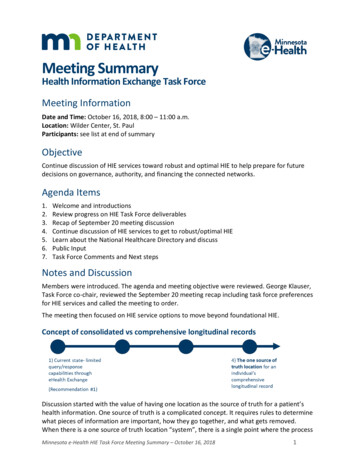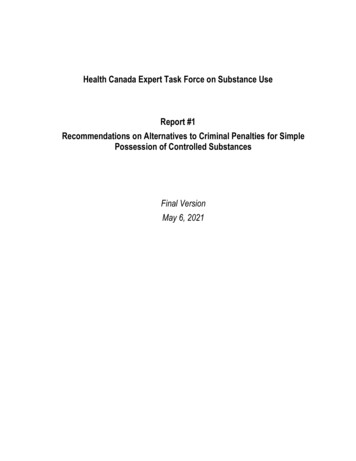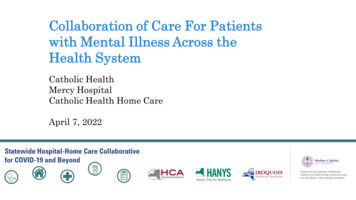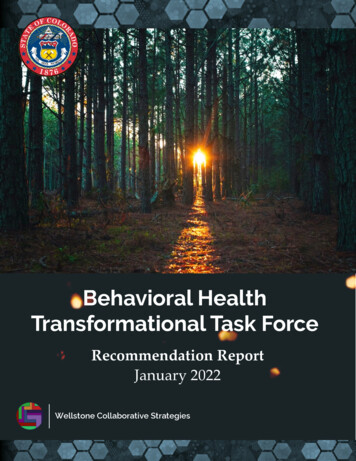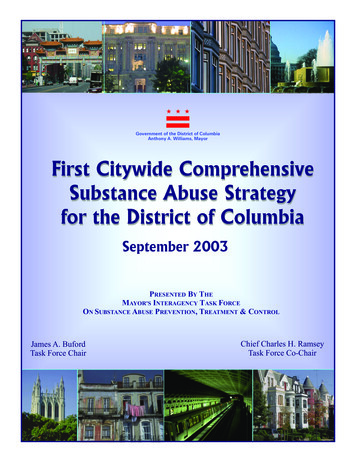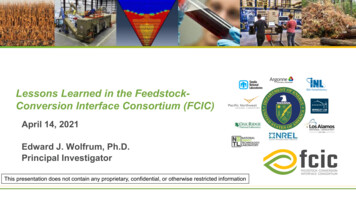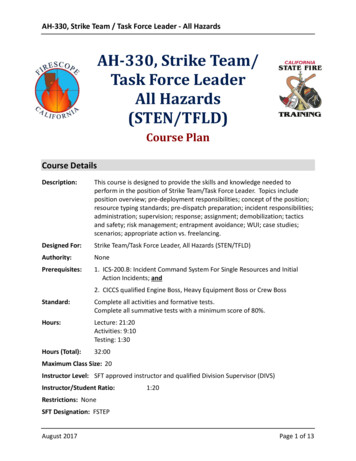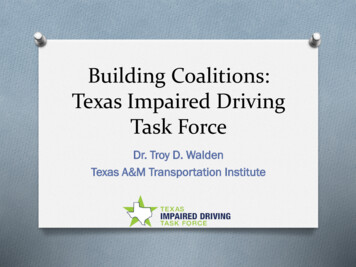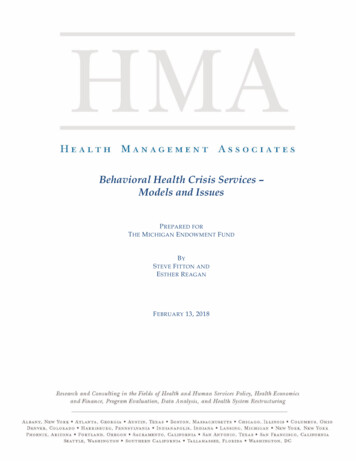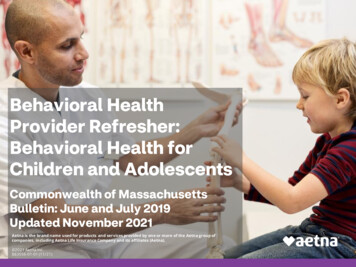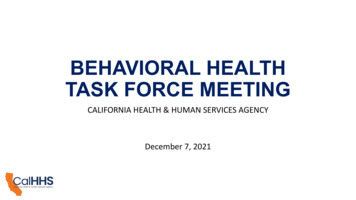
Transcription
BEHAVIORAL HEALTHTASK FORCE MEETINGCALIFORNIA HEALTH & HUMAN SERVICES AGENCYDecember 7, 2021
VIRTUAL MEETING PROTOCOLS Meeting is being recorded American Sign Language interpretation in pinned video Live captioning link provided in chatBHTF MEMBERS Mute/Unmute Functionality to members and policy partners. Stay ON MUTE when not speaking and utilize the “raise hand feature” if you have aquestion or comment. Please turn on your camera and engage Use chat for additional conversationMEMBERS OF THE PUBLIC will be invited to participate during public comments period atthe end of the meeting2
TASK FORCE MEETING AGENDA1. Welcome & Introductions2. Youth Perspective3. Children and Youth Behavioral Health Initiative4. Short Break5. The Work of the BHTF6. The Dynamic and Changing Behavioral Health Environment Task Force Member Discussion7. Next Steps8. Public Comment3
Member IntroductionsWhere in California do you work? SUPERIOR (Butte, Colusa, Del Norte, Glenn, Humboldt, Lake,Lassen, Mendocino, Modoc, Nevada, Plumas, Shasta, Sierra,Siskiyou, Tehama and Trinity) CENTRAL (Alpine, Amador, Calaveras, El Dorado, Fresno, Inyo,Kings, Madera, Mariposa, Merced, Mono, Placer, Sacramento, SanJoaquin, Stanislaus, Sutter, Yuba, Tulare, Tuolumne, and Yolo) BAY AREA (Alameda, Contra Costa, Marin, Monterey, Napa, SanBenito, San Francisco, San Mateo, Santa Clara, Santa Cruz, Solano,Sonoma, and City of Berkeley) SOUTHERN (Imperial, Kern, Orange, Riverside, San Bernardino,San Diego, San Luis Obispo, Santa Barbara, Ventura, and Tri-City(Pomona, Claremont, La Verne)What is the primaryage group that youwork with?(Check all thatapply) 0-5 5-18 18-24 24-65 Over 65 LOS ANGELES (County of Los Angeles) STATEWIDE4
WELCOME & INTRODUCTIONSMARK GHALY, SECRETARY, CalHHSSTEPHANIE WELCH, DEPUTY SECRETARY OF BEHAVIORAL HEALTH, CalHHS5
Orit Kalman, PhDSenior Facilitator/MediatorMelissa Stafford Jones, MPHDirector of the Children and YouthBehavioral Health Initiative, CalHHSJulia Van HornLead Facilitator/MediatorFacilitation TeamCalifornia State University, SacramentoConsensus & Collaboration Program7
YOUTH PERSPECTIVESTEPHANIE WELCH, DEPUTY SECRETARY OF BEHAVIORAL HEALTH, CalHHSMATTHEW DIEP, ASSISTANT PROGRAM MANAGER, MENTAL HEALTH AMERICA OFCALIFORNIAGENIE KIM, DIRECTOR OF STUDENT MENTAL HEALTH AND WELL-BEING,UNIVERSITY OF CALIFORNIA OFFICE OF THE PRESIDENT9
Children and Youth: New BHTF MembersJackie Thu-Huong Wong,First 5 CaliforniaKen Berrick, Seneca Familyof AgenciesMatthew Diep, CaliforniaYouth EmpowermentNetworkGenie Kim, University ofCalifornia Office of thePresident10
CA-YEN.org@ca tworkCAYEN Overview
Our MissionWho Are TransitionalAge Youth?TAY stands for Transitional Age Youth.The term represents young peoplebetween the ages of 15 and 26. TAY arenot children and they are not adults.They are a unique group that requirescustomized services and supports tomeet their distinctive needs.Our mission is to empower Transitional Age Youth(TAY) to be leaders in community and mental healthsystem transformation and to create positive changethrough the promotion of culturally appropriatesupports, services, and approaches that improve andmaintain the mental health of California’s TAY.We envision a community in which Transitional Age Youthin need of mental health services have access toresources and supports so they can lead self-fulfillinglives and be contributing members of society
Warda AliCo-Vice PresidentSacramento CountyMorgan NguyenCo-PresidentLos Angeles CountyAj ArzaluzCo-PresidentSacramento CountyMeet the Officers!Mico MastriliCo-Vice PresidentSacramento CountyFounded in 2006, CAYEN is the Transitional AgeYouth program of Mental Health America ofCalifornia. We are a mental health advocacy boardcomposed of 12 TAY who have been touched by themental health, juvenile justice, or foster caresystems.Zofia TrexlerSecretaryFresno County
CAYEN's Board(continued)ADVOCACYCOMMITTEEEboni Stallworth,Sacramento CountyLorne Wood,Los Angeles CountyXiaoyuan (Claire) Zhang,Alameda CountyDerek Doung,Los Angeles CountyAJ Aguilar,Yolo CountySOCIAL MEDIACOMMITTEEWELLNESSCOMMITTEERiana Youngken,Riverside County
Year 1 & 2 TAY Action TeamsSLAVICASSISTANCECENTERSANTA BARBARA COUNTYSACRAMENTOCOUNTYSAN FRANCISCO COUNTYMONTEREYCOUNTYORANGECOUNTYHUMBOLDT COUNTYLOS ANGELESCOUNTYSACRAMENTO COUNTYBUTTECOUNTY
Year 3 TAY Action TeamsFor year 3, we are partnered withcommunity-based organizationswho already have very strong,established relationships withhigh schools in the counties thatwe are focusing our efforts in.SAN DIEGO COUNTYORANGE COUNTYSAN BENITO COUNTYFRESNO COUNTYTEHAMA COUNTY
CAYEN's Reach Across the State CAYEN's Statewide TAY Board 15 TAY Action Teams across the State California Department of Social ServicesBackbone Committee Mental Health Services Oversight &Accountability Commission (MHSOAC)Anti-Bullying Advisory Committee California Department of Education andMHSOAC Student Mental Health WebinarAdvisory Committee Panels, Conferences, and moreCAYEN was a co-sponsor of SB 224, whichrecently passed to help bring mental healtheducation to schools across California!CAYEN's 2020 State ofthe CommunityReportCAYEN elevates the voices of TAY across the stateby bringing TAY leadership into both local andstatewide behavioral health public policy spaces.We uplift community-specific needs, build strongalliances, and create actionable change together!
Important Lessons Learned Understand where are youth already meeting/convening?Ask who is missing from the conversation? How do we authentically engage them?Identify opportunities for different levels of youth leadership (Hart's Ladder).Developing accessible processes for youth to provide input.Directly incorporate youth input into policies/programs that impact the lives of youth.Setting and communicating clear boundaries to manage expectations and limitations.Commitment to growth demonstrated through concrete action items.Providing appropriate compensation to youth for their leadership, especially when theyare participating outside of the scope of their employment.
Hart's Ladder of Youth Participation8. Young people & adults share decision-making power.7.Young people lead & initiate action.6. Adult-initiated, shared decisions with young people.5. Young people consulted and informed.4. Young people assigned and informed.3. Young people tokenized.2. Young people are decoration.1. Young people are manipulated.
Immediate RecommendationsRe: The Children and Youth Behavioral Health Initiative Use Hart's Ladder to identify different opportunities for youth leadership atdifferent stages of planning and implementation. Bring youth stakeholders into any decision making spaces where adultstakeholders currently have decision making power. Develop a Request for Proposal (RFP) to identify stakeholder(s) who cansupport authentic recruitment and engagement of youth across California. Hold focus groups with a diverse pool of youth impacted by differentsystems in California to inform the points listed above.
Thank you!WEBSITEca-yen.orgEMAIL ADDRESSmdiep@mhac.org
YOUTH VIDEO DIARIESON EXPERIENCES WITHBEHAVIORAL HEALTH12
What are best practices to bringingyouth voices into the BHTF?13
CHILDREN AND YOUTHBEHAVIORAL HEALTHINITIATIVEMELISSA STAFFORD JONES, MPHDIRECTOR OF THE CHILDREN AND YOUTH BEHAVIORAL HEALTH INITIATIVE, CalHHS14
Behavioral Health Task Force:Children and Youth Behavioral HealthInitiative Program UpdateMeeting DocumentDecember 7, 2021Information contained in this file is confidential, preliminary and pre-decisional
Agenda1. Reflect on program aspirations2. Discuss building blocks for stakeholder engagement3. Share high-level roadmap and milestones4. Share available program overview materials16Information contained in this file is confidential, preliminary and pre-decisional
Children and Youth Behavioral Health goal and aspirations (1/2)As of December 3, 2021The goal of the Children and Youth Behavioral Health Initiative is toreimagine the systems that support behavioral health andwellness for California’s children and youth into an innovative, upstream focused, ecosystem where ALL children and youth areroutinely screened, supported, and served for emerging andexisting behavioral health (mental health and substance use) needsSource: California Health and Human Services Agency17Information contained in this file is confidential, preliminary and pre-decisional
Children and Youth Behavioral Health goal and aspirations (2/2)As of December 3, 2021Advance EquityALL children, youth and their families have access to linguistically, culturallyand developmentally appropriate services and supportsDesigned for Youth by YouthChildren and youth are engaged in the design and implementation of servicesand supports; ensuring that programs center on their needsStart Early, Start SmartThe systems that support children, youth, and their families act early bypromoting positive mental health and reducing risk for more significant mentalhealth needs / challengesCenter around Children andYouthAcross all levels of government, child- and youth-serving agencies formcoordinated systems of care to deliver high-quality behavioral health programsresponsive to the needs of youth and their familiesEmpower Families andCommunitiesPeople who teach, work with or care for children and youth are equipped torecognize signs of poor mental health or substance use and know how toaccess supportsRight Time, Right PlaceYouth and children can access high-quality care and information when theyneed it – including early mornings, evenings and weekends and where theyneed it – including where they live, learn, and playFree of StigmaChildren, youth and their families can talk about their mental health and wellbeing and seek help without feeling ashamed or fearing discriminationSource: California Health and Human Services Agency18Information contained in this file is confidential, preliminary and pre-decisional
Questions for discussionAs of December 3, 2021The Children and Youth Behavioral Health Initiative aims to reimaginemental health and emotional well-being for ALL children, youth, andfamilies in California by delivering equitable, appropriate, timely, andaccessible behavioral health services and supports.1. What aspects of the system are most important to reimagine toachieve greater person-centeredness and advance equity?2. How would you define success for this initiative in 5 years?Source: California Health and Human Services Agency19Information contained in this file is confidential, preliminary and pre-decisional
Building blocks for stakeholder engagementAs of December 3, 2021What will be included in the stakeholder engagement plan?The stakeholder engagement plan will outline the approach to engaging stakeholders through thedesign, development, and implementation of the initiative. It will defineWhich stakeholders will be engaged (i.e., stakeholder types and specific organizations)How stakeholders will be engaged (i.e., engagement model, channels, and timeline)Frequency at which stakeholders will be engagedWho will engage the stakeholdersSource: California Health and Human Services Agency20Information contained in this file is confidential, preliminary and pre-decisional
Stakeholder engagement – guiding principlesAs of December 3, 2021Bring diversity of voices to advance equity and address needs for all Californians in a way that centers the experienceand engagement of children, youth, and their familiesReflect perspectives from the field – across the continuum of care / support and across systems and sectorsProvide consistent messaging to build awareness and shared understanding of the programUtilize existing channels where they are effective; establish new channels in a purposeful wayCoordinate and aggregate asks for stakeholder inputs to avoid fatigue and maintain high level of engagementEmbed stakeholder engagement activities in state departments leading program implementationProvide frequent updates and materials as stakeholders may engage with the initiative at different stagesSource: California Health and Human Services Agency21Information contained in this file is confidential, preliminary and pre-decisional
Stakeholder engagement – potential elements to considerAs of December 3, 2021ItemTypes of stakeholdersEngagement modelLevel of involvementDescriptionStakeholder groups that would beengaged as part of the effort.Stakeholders represent a variety offields and sectors (e.g., educationstakeholders, healthcarestakeholders, etc).Models of collaboration that definestakeholder roles and expectationsfrom stakeholders.The engagement model with eachstakeholder may differ by programcomponent and may evolve overthe duration of the effort.Frequency of interaction withstakeholders and level of effort neededto support the selected engagementmodel.The level of involvement of stakeholdersmay evolve over time.ExamplesYouth, families and individuals withlived experienceFederal, state and local governmentpartnersCommunity-based CollaborateOccasionalEducation and health / behavioralhealth providersEmpowerSource: California Health and Human Services Agency22Information contained in this file is confidential, preliminary and pre-decisional
Potential types of stakeholdersAs of December 3, 2021Individuals withlived experienceFederal, state and localgovernment partnersSubject matterexpertsCommunity partnersand stakeholders on theground and in the fieldSource: California Health and Human Services Agency23Information contained in this file is confidential, preliminary and pre-decisional
Potential stakeholder engagement modelsAs of December 3, riptionInform oreducatestakeholdersObtain informationand feedback fromstakeholders toinform decisionsWork directly withstakeholdersthroughout theprocess to ensurethat issues andconcerns areunderstood andconsideredPartner withstakeholders(groups) for thedevelopment ofmutually agreedsolutions and jointplan of actionDelegate decisionmaking in the hands of thestakeholders. Stakeholdersare enabled/equipped toactively contribute to theachievement of outcomesPromise tostakeholders“We willkeep youinformed”“We will keep youinformed, listen toand acknowledgeyour concerns, andprovide feedback onhow input influencedthe decision”“We will work withyou to ensure thatyour concerns andissues are directlyreflected inalternativesdeveloped andprovide feedback onhow input influencedthe decision”“We will worktogether to agree onwhat we willimplement andincorporate youradvice andrecommendationsinto the decisions tothe maximumextent possible”“We will implement whatyou decide and we willsupport and complementyour actions”Source: IAP2. Spectrum of Public Participation24Information contained in this file is confidential, preliminary and pre-decisional
Questions for discussion – Linking your experience/expertise to the CYBHI1. How could you bring engagement and insights fromstakeholders/ groups that you are part of to the BehavioralHealth Task Force?2. How can CalHHS support you or your organization/constituency to bring those insights to the Behavioral HealthTask Force?3. What are some examples of existing forums and channels,where CalHHS and its departments do not currently participate,that would have important insights to provide on the initiative?Source: California Health and Human Services Agency25Information contained in this file is confidential, preliminary and pre-decisional
Milestones in July 2021 – June 2022As of December 3, 20211234Expand equitable access,with no wrong door forchildren, youth, and familiesBuild capacity for prevention,treatment, and recoveryservicesRaise awareness andengage communities andfamiliesDeliver behavioral health careservices and supports thatworkBehavioral health platform:Identify critical features andprepare to select technologypartner(s)Behavioral health workforce:Release BH workforceframework for BH counselorsand coaches as well as SUDworkforcePublic education andawareness:Complete trauma-informedtraining for educatorsEvidence-based andcommunity-defined practices:Identify evidence-based andcommunity-defined programs forroll outContinuum of care: Completecapacity and gap analysis;prepare to administer grantsPrepare to launch culturallyspecific public educationand awareness campaignsSelect a third-party grantadministratorStart administering grantsYouth voice and family/community engagementActivate youth, family, and community engagement through existing and new channels and forumsIntegration, evaluation andcontinuous improvementLaunch regular program performance reporting and release approach to program evaluationEstablish and maintain expert forums and stakeholder workgroups to provide support across programcomponentsSource: California Health and Human Services Agency26Information contained in this file is confidential, preliminary and pre-decisional
Integrated 5-year roadmap (1/2)As of December 3, 2021Step1. Expandequitableaccess202120222023Behavioralhealth servicesplatformSchool-linkedand schoolbased servicesSchool-linked capacity /infrastructure grantsEnhancedprimary caresystemExpandedbehavioralhealthworkforce2025BH service virtual platformincluding e-ConsultStatewide behavioral healthnetwork and fee structure forschool-based servicesIssue initial guidance forcommercial plans2. Buildservicecapacity2024Begin enforcementProvider educationcampaignComplete BH/ SUD needs andlandscape analysis and releaseSUD and BH CoachesframeworksLaunch broad BH initiativeswhen ready and begin programevaluation designAdminister award cycles forbroad BH initiatives andbegin program evaluationAdminister award cycles andconduct program evaluationAdminister awardcycles and conductprogram evaluationLaunch BH Coaches trainingprogram and SUD award cycleAdminister award cycles anddesign program evaluationAdminister award cycles andbegin program evaluationAdminister awardcycles and beginprogram evaluationSource: CalHHS, HCAI, CDPH, OSG, DMHC, DHCS Major Program Initiatives Go Live as of 10/13/202127Information contained in this file is confidential, preliminary and pre-decisional
Integrated 5-year roadmap (2/2)As of December 3, 2021Step3. Raiseawareness andengage4. Provide BHservices andsupports5. Youth voiceand family/communityengagement6. Integration,evaluation andcontinuousimprovementPubliceducation andACEsawareness202120222023Launch provider ACEseducation campaignLaunch ACEs and toxic stresspublic aware-ness campaignEvaluate success/ challengesof trauma-informed training foreducatorsPromote CYBHI viastakeholderengagement andmedia appearanceComplete trauma-informedtraining for educatorsEvidence- andcommunitybasedpractices20242025BH evidence-based programsgrantsLaunch youth digitaldiariesActivate youth engagementforumsSet up Delivery UnitIssue RFP for programevaluation partnerLaunch on-going evaluationeffortsSource: CalHHS, HCAI, CDPH, OSG, DMHC, DHCS Major Program Initiatives Go Live as of 10/13/202128Information contained in this file is confidential, preliminary and pre-decisional
Question for discussion – Short and long-term accomplishmentsWhat is the BHTF’s advice and suggestions on how we canensure simultaneous progress on both addressing the needsof children and youth today AND doing the longer-termsystems reimagining/change work of the CYBHI?Source: California Health and Human Services Agency29Information contained in this file is confidential, preliminary and pre-decisional
30Program overview materialsProgram BriefDocument describing the initiative including goals,background, initial focus areas / components, timelinesand milestonesProgram webpage Webpage containing information about the initiativeand contact information for questions, comments,feedback Webpage will be continuously updated with relevantprogram information [Placeholder for webpage link]Source: California Health and Human Services Agency30Information contained in this file is confidential, preliminary and pre-decisional
SHORT BREAK31
THE WORK OF THE BHTFSTEPHANIE WELCH, DEPUTY SECRETARY OF BEHAVIORAL HEALTH, CalHHSORIT KALMAN, SENIOR FACILITATOR, CONSENSUS & COLLABORATION PROGRAM32
CalHHS Guiding PrinciplesFocus on EquityActively ListenUse Data to Drive ActionSee the Whole PersonPut the Person back in Person-CenteredCultivate a Culture of InnovationDeliver on Outcomes33
CalHHS Strategic PrioritiesCreate an Equitable Pandemic RecoveryBuild a Healthy California for AllIntegrate Health and Human ServicesImprove the Lives of California’s MostVulnerableAdvancing the Well-Being of Children and YouthBuild an Age-Friendly State for All34
The Work of the BHTFOrit Kalman, Senior Facilitator, CSUS - CCPJulia Van Horn, Lead Facilitator, CSUS - CCP35
The Role of theBehavioral Health Task Force“Addressing urgent mental health andsubstance use disorder needs acrossCalifornia”.What does it mean in the context of theBehavioral Health Task Force?36
Developing a Task Force Charter - Process123Dec 2021/Jan 2022Interview key CalHHSleadership and staffJan/Feb 2022Survey Task ForcemembersEarly 2022 TF MeetingShare initial input forfurther discussion andrefinement37
Developing a Task Force Charter:Key Components1. Purpose and scope: What is our shared agenda as a TaskForce?2. Guiding Principles: What is the culture and approach to ourshared work?3. Membership: Who’s voice need to be at the table?4. Evaluation process: How do we assess our impact and success?5. Engagement: How do we connect and leverage the differentspheres that members engage in?6. Communication: How do we ensure transparent and inclusiveenvironment that promotes equity and learning?38
What are the necessary ingredients fora successful Task Force?39
THE DYNAMIC & CHANGINGBEHAVIORAL HEALTH ENVIRONMENTTASK FORCE MEMBERS OPEN DISCUSSIONHow does the work that you do in your world relate to the CYBHI?40
NEXT STEPSSTEPHANIE WELCH, DEPUTY SECRETARY OF BEHAVIORAL HEALTH, CalHHS41
PUBLIC COMMENT Please use the “raise hand function” and you will be unmuted inorder to make comments Via phone, dial *9 to raise hand Please state your name and affiliation prior to public comment Please be succinct Comments can also be emailed toBehavioralHealthTaskForce@chhs.ca.gov42
Thank you!California Health & Human Services Agency43
Sacramento County . Meet the Officers! Founded in 2006, CAYEN is the Transitional Age Youth program of Mental Health America of California. We are a mental health advocacy board composed of 12 TAY who have been touched by the mental health, juvenile justice, or foster care systems. Mico Mastrili Co-Vice President Sacramento County . Zofia Trexler

